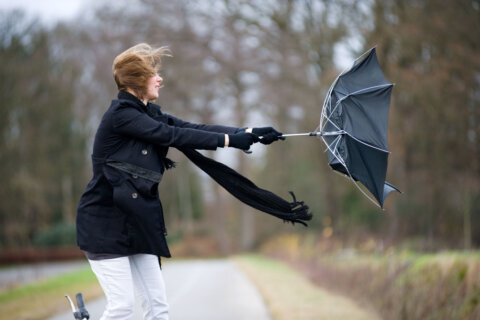WASHINGTON – Freezing rain can cause some of the worst driving conditions, according to a driving expert from Michelin, who has tips to help you drive and arrive safely during any hazardous mix of freezing rain, snow and ice.
“Freezing rain is just atrocious,” says Carl Nadeau, chief instructor of the Michelin Winter Driving Academy.
To avoid sliding into that ditch or guard rail, Nadeau says to look where you want to go. He says people have an uncanny ability to fixate on, and hit, things like parked cars.
“If you are looking at it, you are going to aim for it,” he says.
He also says drivers should sit up straight and keep a loose grip on the steering wheel so your car can give you feedback. Otherwise, that white-knuckle grip can actually contribute to you spinning out of control.
“When you hit the threshold, if you hold the steering wheel too tight, you’re not going to feel the threshold, so by the time you are going to feel it, it’s already too late,” Nadeau says.
He also says not to peer over the hood to look for slick spots. Instead focus your eyes further ahead to see what you are approaching like snow-covered pavement or stopped cars.
More Tips for Driving in Snow and Ice
The best tip that can be given for bad weather conditions is not to drive if you don’t have to. If you absolutely have to drive, here are some tips from The Weather Channel on driving in snow and ice:
- Make sure your car is prepared, and that you know how to handle road conditions.
- It’s helpful to practice winter driving techniques in a snowy, open parking lot, so you’re familiar with how your car handles. Consult your owner’s manual for tips specific to your vehicle.
Driving safely on icy roads
- Decrease your speed and leave yourself plenty of room to stop. You should allow at least three times more space than usual between you and the car in front of you.
- Brake gently to avoid skidding. If your wheels start to lock up, ease off the brake.
- Turn on your lights to increase your visibility to other motorists.
- Keep your lights and windshield clean.
- Use low gears to keep traction, especially on hills.
- Don’t use cruise control or overdrive on icy roads.
- Be especially careful on bridges, overpasses and infrequently traveled roads, which will freeze first. Even at temperatures above freezing, if the conditions are wet, you might encounter ice in shady areas or on exposed roadways like bridges.
- Don’t pass snow plows and sanding trucks. The drivers have limited visibility, and you’re likely to find the road in front of them worse than the road behind.
- Don’t assume your vehicle can handle all conditions. Even four-wheel and front-wheel drive vehicles can encounter trouble on winter roads.
If your rear wheels skid…
- Take your foot off the accelerator.
- Steer in the direction you want the front wheels to go. If your rear wheels are sliding left, steer left. If they’re sliding right, steer right.
- If your rear wheels start sliding the other way as you recover, ease the steering wheel toward that side. You might have to steer left and right a few times to get your vehicle completely under control.
- If you have standard brakes, pump them gently.
- If you have anti-lock brakes (ABS), do not pump the brakes. Apply steady pressure to the brakes. You will feel the brakes pulse — this is normal.
If your front wheels skid…
- Take your foot off the gas and shift to neutral, but don’t try to steer immediately.
- As the wheels skid sideways, they will slow the vehicle and traction will return. As it does, steer in the direction you want to go. Then put the transmission in “drive” or release the clutch, and accelerate gently.
If you get stuck…
- Do not spin your wheels. This will only dig you in deeper.
- Turn your wheels from side to side a few times to push snow out of the way.
- Use a light touch on the gas, to ease your car out.
- Use a shovel to clear snow away from the wheels and the underside of the car.
- Pour sand, kitty litter, gravel or salt in the path of the wheels, to help get traction.
- Try rocking the vehicle. (Check your owner’s manual first — it can damage the transmission on some vehicles.) Shift from forward to reverse, and back again. Each time you’re in gear, give a light touch on the gas until the vehicle gets going.
Sources: National Safety Council, New York State Department of Motor Vehicles, Washington State Government Information & Services
Make sure your car has an emergency kit. Here’s what AAA recommends you put in it:
- Cellphone
- Blankets/sleeping bags
- Flashlight with extra batteries
- First-aid kit
- Drinking water
- Extra clothes
- Sand or cat litter for traction
- Shovel
- Scraper/brush
- Jumper cables
- Tool kit
- Flares or orange triangles
- Knife
- Towels
- High calorie, non-perishable food
WTOP’s John Aaron and Paula Wolfson contributed to this report. Follow @WTOP on Twitter.







